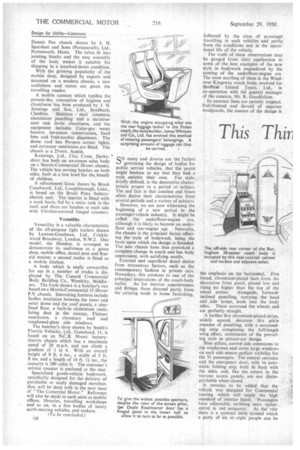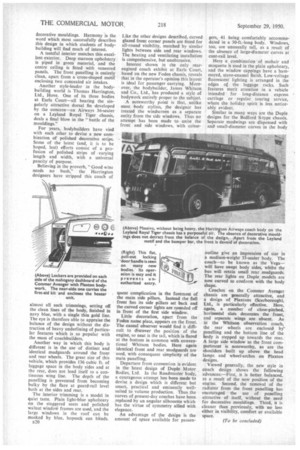This Thir STYLE
Page 52

Page 53

Page 54

If you've noticed an error in this article please click here to report it so we can fix it.
New Chassis HaveInspired New Styles in Coach Bodies. Good Proportions and Increased Comfort Have Resulted
By Alfred Woolf,
B.A.
SO many and diverse are the factors governing the design of bodies for public service vehicles, that the purist might hesitate to say that they had a
style entirely their own. For style. briefly defined, is the decorative characteristic proper to a period or subject. The sad fact is that coaches and buses often derive their characteristics from several periods and a variety of subjects. However, we are now witnessing the beginning of a new period in the passenger-vehicle industry. It might be called the underfloor-engine era, although it is likely to become an underfloor and rear-engine age. Naturally, the chassis is the principal factor affecting the 'style of bodywork, being the basis upon which the design is founded. The new chassis have thus provoked a complete change in coach and bus body appearance, wi h satisfying results.
External and superficial detail derive from extraneous factors, such as the contemporary fashion in private cars. Nowadays, this amounts to one of the principal inspirations of the coach-body stylist. As for interior appointments and fittings, these descend partly from the existing mode in home furnishing. followed by the class of passenger travelling in such vehicles and partly from the conditions met in the operational life of the vehicle.
The truth of these observations may be gauged from their application to some of the best examples of the new style in bodywork engendered by the coming of the underfloor-engine era The most startling of these is the Windover Kingsway coach body, evolved for Sheffield United Tours, Ltd., in co-operation with the general manager of the concern, Mr. R. Goodfellow.
Its external lines are entirely original. Full-fronted and devoid of separate mudguards, the essence of the design is the emphasis on the horizontal Five broad, chromium-plated bars form the decorative front panel, placed low and rising no higher than the top of the wheel arches. Alongside, forwardinclined panelling, carrying the head and side lamps, leads into the body sides. These surround the wheels and are perfectly straight.
A further five chromium-plated strips, widely spaced, decorate th!s plain expanse of panelling, with a surrounding strip completing the full-length wing effect, reminiscent of the prevailing style in private-car design.
Slim pillars, curved side extensions to the windscreen and seven large windows on each side ensure perfect visibility for the 31 passengers. The central entrance and the emergency door, with its automatic folding step, both fit flush with the sides, and, like the covers to the various access panels, are not distinguishable when closed.
It remains to be added that the vehicle was designed for Continental touring, which will imply the high standard of interior finish. Passengers have adjustable, reclining seats, upholstered in red moquette. At the rear there is a cocktail table around which a party of Six or eight people can be
entertained. Behind the driver's half
partition is a small bar from which the courier can dispense refreshments during short halts. Restful to the eye, the interior is as neat and yet as distinctive as the exterior, which exhibits signs of the operator's overseas experience, particularly in the rear luggage-locker doors—a panel-beater's triumph—into which the body sides lead, giving the effect of an external locker.
Equally impressive is the Burlingham design, also on an A.E.C. Regal Mk. IV chassis, like the Windover model, but displayed as well, in a style suitable for home-country tours, on a Leyland Royal Tiger chassis. Here the bodybuilder has built out the side panels of the body to give the full-length-wing effect, the front and rear sweeps around the wheels, having the same curve and resulting in a particularly well-balanced symmetrical coach. A bulged panel at the rear of the Leyland 35-seater encloses the bumper bar, and neatly finishes off the tail. Frontal treatment is similar, the bulga being outlined with a polished strip.
On the A.E.C„ designed for Continental touring and incorporating a toilet and cocktail bar, full use is made of the curved sides of the roof by means of glazed panels to give good visibility in mountainous country. Both panels of the opening windscreen arc curved horizontally and vertically, and the smooth shape of the body is outstanding for the manner in which the lines have been tied up without irrelevant
decorative mouldings. Harmony is the word which most successfully describes this design in which students of bodybuilding will find much of interest.
A tasteful interior matches this excellent exterior. Deep maroon upholstery is piped in green material, and the centre ceiling is fitted with veneered panels. The front panelling is entirely clean, apart from a cross-shaped motif enclosing two concealed air intakes.
Another style-leader in the bodybuilding world is Thomas Harrington, Ltd., Hove. One of its three bodies at Earls Court—all bearing the singularly attractive dorsal fin developed by the concern—an Airways 36-seater on a Leyland Royal Tiger chassis, deals a final blow in the "battle of the mouldings."
For years, bodybuilders have vied with each other to devise a new combination of polished decorative strips. Some of the latest (and, it is to be hoped, last) efforts consist of a profusion of polished strips of varying length and width, with a universal paucity of purpose.
Believing in the proverb, "Good wine needs no bush," the Harrington designers have stripped this coach of almost all such trimmings, setting off the clean lines of the body, finished in navy blue, with a single thin gold line. The eye is therefore able to appraise the balance of the design without the distraction of heavy underlining of particular features which is so popular with the mass of coachbuilders.
Another way in which this body is different is in the use of distinct and identical mudguards around the front and rear wheels. The great size of this vehicle, which provides 136 cubic ft. of luggage space in the body sides and at the rear, does not lend itself to a continuous wing line. The depth of the panelling is prevented from becoming bulky by the flare at guard-rail level both at the sides and rear.
The interior trimming is a model in quiet taste. Plain light-blue upholstery on the staggered seats and polished walnut windosir frames are used, and the large windows in the roof can be masked by blue, hopsack sun blinds.
n/0 Like the other designs described, curved glazed front corner panels are fitted for all-round visibility, matched by similar lights between side and rear windows. The heating and ventilating installation is comprehensive, but unobtrusive.
Interest shown in the only rearengined coach exhibit at Earls Court, based on the new Foden chassis, reveals that in the operator's opinion this layout is ideal for passenger carrying. Moreover, the bodybuilder, James Whitson and Co., Ltd., has produced a style of bodywork entirely proper to the subject.
A noteworthy point is that, :unlike most body stylists, the designer has treated the windscreen as a separate entity from the side windows. Thus no attempt has been made to unite the front and side windows, with conse quent complication in the foremost of the main side pillars. Instead the full front has its side pillars set luck and the curved corner lights are rounded off in front of the first side window.
Little decoration, apart from the Foden name plate, appears on the front. The casual observer would find it difficult to discover the position of the engine, so neat is the tail, which is flared at the bottom in common with conventional Whitson bodies. Here again identical front and rear mudguards are used, with consequent simplicity of the main panelling.
Departure from convention is evident in the latest design of Duple Motor Bodies, Ltd. In the Roadmaster body, a courageous attempt has been made to devise a design which is different but smart, practical and eminently wellsuited to volume production. Thus the curves of present-day coaches have been replaced by an angular silhouette wh:ch has the virtue of symmetry allied with elegance.
An advantage of the design is the amount of space available for passen
gers, 41 being comfortably accommodated in a 30-ft.-long body. Windows, too, are unusually tall, as a result of the absence of large-diameter curves at cant-rail level.
Here a combination of mohair and moquette is used in the plain upholstery, and the window cappings have a hammered, stove-enamel finish. Low-voltage fluorescent lighting is arranged in the edges of the luggage racks. Such features merit attention in a vehicle intended for long-distance express carriage or regular touring service, where the holiday spirit is less noticeably evident.
Similar in many ways are the Duple designs for the Bedford S-type chassis. Separate mudwings are dispensed with and small-diameter curves in the body outline give an impression of size in a medium-weight 33-seater body. The coach—to be known as the Vega— will have swept body sides, whilst the bus will retain small rear mudguards. The rear lights on Duple models are now curved to conform with the body shape.
Coaches on the Commer Avenger chassis are generally attractive, and a design of Plaxtons (Scarborough). Ltd., is particularly effective. Here, again, a number of close-pitched, horizontal slats decorates the front, and separate wings are absent. As in the Whitson observation coach, the rear wheels are enclosed by' panelling and the bottom line of the body is stepped up towards the rear. A large side window to the front cornpartmenrt is noteworthy, as are the shoulders built up above the head lamps and wheel-arches on Plaxton designs.
Viewed generally, the new style in coach design shows the following advances:—First, it is better balanced, as a result of the new position of the engine. Second, the removal of the radiator from the front panelling has encouraged the use of panelling attractive of itself, without the need for decorative mouldings. Third, it is cleaner than previously, with no loss either in visibility, comfort or available space.
(To be concluded)




























































































